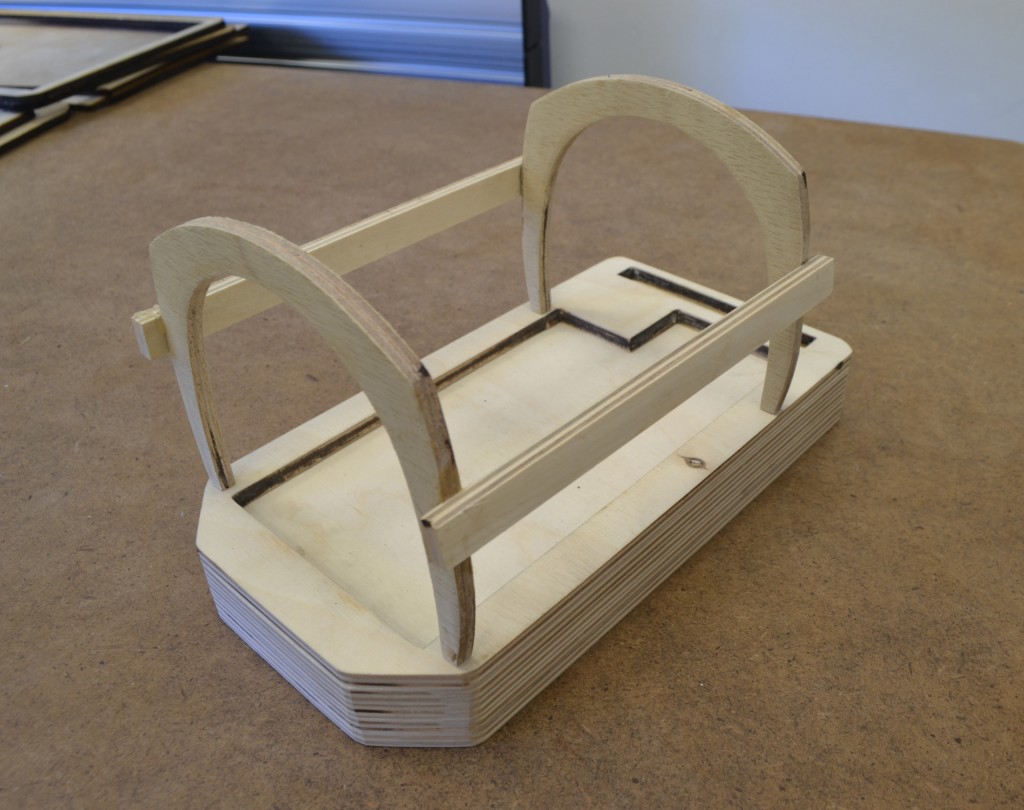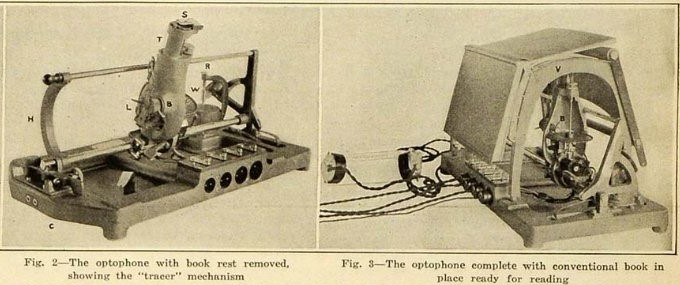By: Tiffany Chan, Victoria Murawski, and Jentery Sayers
In our lab at the University of Victoria, we are currently remaking a reading optophone: an aid for the blind that converted text into sound during the twentieth century. Although the reading optophone never existed in a stable or fixed form, a common configuration involved operators placing books and other print materials on glass. They then used a handle to move a reading head located below the glass, sliding it back and forth to scan pages. As pages were scanned, the machine would express type as a series of audible tones. To listen, operators plugged telephone receivers into the device and wore them over their ears, like headphones.

As Figure 1 suggests, reading optophones had open frames, which encouraged a variety of interactions. The structural transparency allowed operators to physically control the pace and location of reading. Operators could also tune the optophone with a knob, as observers witnessed how they used the machine. Watching someone control the instrument while also seeing the mechanism move created an experience that was social, linking observer, operator, and machine through the material processes of text-to-sound conversion. This unique configuration produced an interesting tension: even though the architecture of reading optophones was open, it facilitated a private acoustic sphere premised on dedicated listening.
Today, optophones are typically interpreted as precursors to optical character recognition (OCR), or the automated conversion of images into machine-readable text. However, that origin story risks bypassing how optophones were developed and maintained. Pictured in Figure 2, Mary Jameson, who was blind, played a central role in this development, while E. E. Fournier d’Albe is credited with the invention (in 1913).

By remaking optophones, we hope to better understand how they changed over time, beyond their point of invention, with awareness of Jameson’s key role as a demonstrator or “user.” In fact, we believe descriptions of Jameson as a demonstrator or user diminish her contributions to media history. The process of remaking highlights how much unrecognized labor she contributed to the project over time. Without assuming we (or anyone else) can ever inhabit her embodied position in time, or empathize with how she experienced the world during the 1900s, we are remaking optophones to communicate how Jameson helped the machine. Inspired by the work of Morgan Ames (2014), Daniela Rosner (2014), and Jonathan Sterne (2003), we refer to this approach as “maintenance studies.”
Below are some notes detailing our approach thus far. They are organized into sections corresponding with the structure of early optophones (1910s-1920s), and they offer a sense of the decisions involved when remaking early technologies. If you are interested in a more detailed history of optophones, then we recommend “Optophones and Musical Print” (2015), by Mara Mills; “Machine Head” (2001), by Jacques Donguy; and Harmony and Dissent (2008), by Bruce Elder. Mills’s publication includes samples of optophonic audio.
The Frame
We began remaking an optophone frame by using historical diagrams, descriptions, images, and videos to build a 3-D model in SketchUp. During this process, we also consulted historians and archivists, namely Robert Baker (Blind Veterans UK), Mara Mills (New York University), and Matthew Rubery (Queen Mary University of London). Since no source material was absolute in its articulation of how optophones looked and functioned, we combined digital images with printed matter to approximate dimensions. Early in this process, we resolved information gaps (e.g., how optophones existed in space) via a close analysis of the images’ spatial interiority in comparison with how tactile models stood not only in the lab but also in relation to our bodies.
After approximating dimensions, we began the 3-D modelling process by visually reducing the instrument’s frame to its basic components: a solid rectangular metal plate for the base, two supporting metal arches, and two long, rectangular metal bars that hold these arches in place. We further reduced these components to basic shapes by drawing them (Figure 3): a rectangle, arch, and narrow rectangle.

We imported the drawing into SketchUp and then traced the outline to render it recognizable to the program. When the outline was complete, we used SketchUp’s push/pull tool to transform the 2-D outline into a 3-D form (Figure 4).

After we repeated this process for all forms, we prepared them for laser cutting by exploding the 3-D models into component parts (Figure 5).

After the parts were cut into wood and removed from the door skin, we stacked, glued, and assembled the scattered components into a cohesive frame (Figure 6), which bears resemblance to early optophones. As we proceed with the research, the frame’s design will be adjusted to accommodate the spatial and physical needs of our prototype during testing.

The Mechanism
To remake mechanisms for optophones, we are using physical computing and computer vision techniques. First, we installed a computer vision library (OpenCV) on a Raspberry Pi (RPi). OpenCV allows people to write scripts that detect images (or patterns) within images, and then convert them into other formats, such as text. In our case, we are using it to scan print materials, output the results in plain text, and process the text algorithmically into sound. We dedicate this entire process to an RPi with a camera (PiCamera), which is small enough to fit and maneuver inside our prototype’s frame.

Together, an RPi and camera comprise a present-day version of a “tracer” (Figure 8): the mechanism that actually converted printed material into an electrical signal and then into sound.

Tracers were made with selenium, which becomes more or less conductive based on light absorption. They would scan words with beams of light, each keyed to a different frequency. These beams would produce a continuous stream of noise and silence corresponding with their movement across the page. Some iterations produced tones when they scanned type (“black-sounder”), while others produced tones when they scanned negative space (“white-sounder”). As we mentioned earlier, these tones could be played through telephone receivers that operators wore on their ears. With practice in this dedicated acoustic space, operators learned to interpret each tone or series of tones as letters and words. Historical documents suggest that, after years of practice, Mary Jameson read at a rate of up to 60-words-per-minute on a black-sounder.

For our prototype, we are using the Python programming language to map each character to a separate tone, with playback intended for earphones. As such, our prototype will produce a character-by-character conversion of text to sound, as opposed to a continuous (or analog) stream. However, our goal is not to create an exact replica of an early optophone; it is to better understand how optophones were used and maintained, across the various versions of the device we know existed.
From Technical Particulars to Maintenance Practices
At the moment, we are currently prototyping each of these versions with plans to exhibit them. Even if these prototypes are not identical to early optophones, they do draw our attention to matters of affordance and composition that are absent from existing documentation and scholarship. Thus far, our findings suggest that this approach to maintenance practices offers a counterpoint to masculine, “make or break” narratives prevalent in optophone histories (e.g., see The Moon Element, by Fournier d’Albe), which privilege innovation and disruption, often through hyperbole (e.g., sighted people’s positivist descriptions of optophones). Meanwhile, our emphasis on maintenance directs us to Jameson instead of Fournier d’Albe, and in so doing draws our attention to her absence in most of the historical documentation. Additionally, it refrains from flattening the many versions of optophones into the optophone, with some skepticism toward grand origin stories and even obsolescence. With these many versions in mind, we can investigate how and why Jameson helped the machine persist over time.
True, the description above is rather technical, but the material particulars are not what interest us most about optophones. Instead, we focus on what actions and contexts were likely required to make optophones work. Given Jameson is notably absent from accounts we have encountered thus far, this also means remaking optophones is entangled with rewriting their histories. Indeed, prototyping is not an end in itself but rather a line of inquiry that shapes how we interpret and communicate the past. It expands the very definition of “making” to include writing, which is central to what we do in the lab.
Acknowledgements
This research was supported by the Social Sciences and Humanities Research Council of Canada, the Canada Foundation for Innovation, and the British Columbia Knowledge Development Foundation. It was conducted by Tiffany Chan, Katherine Goertz, Danielle Morgan, Victoria Murawski, Jentery Sayers, and the Maker Lab in the Humanities at the University of Victoria.
About the Authors
Tiffany Chan is a MA student in English and Digital Humanities. Victoria Murawski is a MFA student in Visual Arts. Jentery Sayers is Assistant Professor of English and Director of the Maker Lab in the Humanities. For more on the Kits for Cultural History project, see the Maker Lab website.
Works Cited
Donguy, Jacques. “Machine Head: Raoul Housmann and the Optophone.” Leonardo 34.3 (2001): 217-20.
Elder, Bruce. Harmony and Dissent. London, Canada: Wilfred Laurier University Press, 2008.
Fournier d’Albe, E. E. The Moon Element: An Introduction to the Wonders of Selenium. New York: D Appleton and Company, 1924.
Mills, Mara. “Optophones and Musical Print.” Sounding Out. 5 Jan 2015. soundstudiesblog.com/2015/01/05/optophones-and-musical-print.
Rosner, Daniela K. and Ames, Morgan G. “Designing for Repair? Infrastructures and Materialities of Breakdown.” Proceedings from CSCW ‘14, Feb 15-19, 2014 in Baltimore, Maryland. New York: Association for Computing Machinery, 2014.
Rubery, Matthew and Heather Tilley. How We Read: A Sensory History of Books for Blind People. Nov. 2014. howweread.co.uk.
Sterne, Jonathan. The Audible Past: Cultural Origins of Sound Reproduction. Durham, NC: Duke University Press, 2003.
